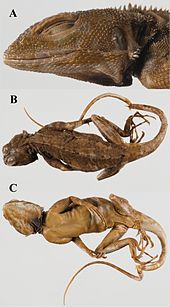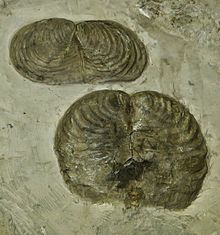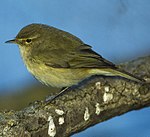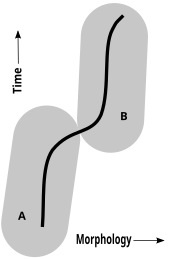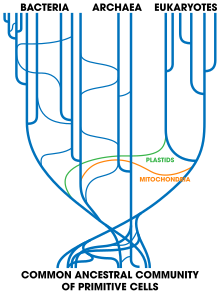Species
Definition
In biology, a species is the basic unit of classification and a taxonomic rank, as well as a unit of biodiversity, but it has proven difficult to find a satisfactory definition. Scientists and conservationists need a species definition which allows them to work, regardless of the theoretical difficulties. If as Linnaeus thought, species were fixed and clearly distinct from one another, there would be no problem, but evolutionary processes cause species to change continually, and to grade into one another. A species is often defined as the largest group of organisms in which two individuals can produce fertile offspring, typically by sexual reproduction. While this definition is often adequate, when looked at more closely it is problematic. For example, with hybridisation, in a species complex of hundreds of similar microspecies, or in a ring species, the boundaries between closely related species become unclear. Among organisms that reproduce only asexually, the concept of a reproductive species breaks down, and each clone is potentially a microspecies. Problems also arise when dealing with fossils, since reproduction cannot be examined; the concept of the chronospecies is therefore used in palaeontology. Other ways of defining species include their karyotype, DNA sequence, morphology, behaviour or ecological niche.
All species are given a two-part name, a "binomial". The first part of a binomial is the genus to which the species belongs. The second part is called the specific name or the specific epithet (in botanical nomenclature, also sometimes in zoological nomenclature). For example, Boa constrictor is one of four species of the genus Boa.
Species were seen from the time of Aristotle until the 18th century as fixed kinds that could be arranged in a hierarchy, the great chain of being. In the 19th century, biologists grasped that species could evolve given sufficient time. Charles Darwin's 1859 book The Origin of Species explained how species could ariseby natural selection. That understanding was greatly extended in the 20th century through genetics and population ecology. Genetic variability arises from mutations and recombination, while organisms themselves are mobile, leading to geographical isolation and genetic drift with varying selection pressures. Genes can sometimes be exchanged between species by horizontal gene transfer; new species can arise rapidly through hybridisation and polyploidy; and species may become extinct for a variety of reasons. Viruses are a special case, driven by a balance of mutation and selection, and can be treated as quasispecies.
As a practical matter, species concepts may be used to define species that are then used to measure biodiversity, though whether this is a good measure is disputed, as other measures are possible.
History
Classical forms
In his biology, Aristotle used the term γένος (génos) to mean a kind, such as a bird or fish, and εἶδος (eidos) to mean a specific form within a kind, such as (within the birds) the crane, eagle, crow, or sparrow. These terms were translated into Latin as "genus" and "species", though they do not correspond to the Linnean terms thus named; today the birds are a class, the cranes are a family, and the crows a genus. A kind was distinguished by its attributes; for instance, a bird has feathers, a beak, wings, a hard-shelled egg, and warm blood. A form was distinguished by being shared by all its members, the young inheriting any variations they might have from their parents. Aristotle believed all kinds and forms to be distinct and unchanging. His approach remained influential until the Renaissance.
Fixed species
When observers in the Early Modern period began to develop systems of organization for living things, they placed each kind of animal or plant into a context. Many of these early delineation schemes would now be considered whimsical: schemes included consanguinity based on colour (all plants with yellow flowers) or behaviour (snakes, scorpions and certain biting ants). John Ray, an English naturalist, was the first to attempt a biological definition of species in 1686, as follows:
In the 18th century, the Swedish scientist Carl Linnaeus classified organisms according to shared physical characteristics, and not simply based upon differences. He established the idea of a taxonomic hierarchy of classification based upon observable characteristics and intended to reflect natural relationships. At the time, however, it was still widely believed that there was no organic connection between species, no matter how similar they appeared. This view was influenced by European scholarly and religious education, which held that the categories of life are dictated by God, forming an Aristotelian hierarchy, the scala naturae or great chain of being. However, whether or not it was supposed to be fixed, the scala (a ladder) inherently implied the possibility of climbing.
The possibility of change
Faced with evidence of hybridisation, Linnaeus came to accept that species could change, and the struggle for survival, but not that new species could freely evolve. By the 19th century, naturalists understood that species could change form over time, and that the history of the planet provided enough time for major changes. Jean-Baptiste Lamarck, in his 1809 Zoological Philosophy, described the transmutation of species, proposing that a species could change over time, in a radical departure from Aristotelian thinking.
In 1859, Charles Darwin and Alfred Russel Wallace provided a compelling account of evolution and the formation of new species. Darwin argued that it was populations that evolved, not individuals, by natural selection from naturally occurring variation among individuals. This required a new definition of species. Darwin concluded that species are what they appear to be: ideas, provisionally useful for naming groups of interacting individuals, writing:
Taxonomy and naming
Common and scientific names
The commonly used names for kinds of organisms are often ambiguous: "cat" could mean the domestic cat, Felis catus, or the cat family, Felidae. Another problem with common names is that they often vary from place to place, so that puma, cougar, catamount, panther, painter and mountain lion all mean Puma concolor in various parts of America, while "panther" may also mean the jaguar (Panthera onca) of Latin America or the leopard(Panthera pardus) of Africa and Asia. In contrast, the scientific names of species are chosen to be unique and universal; they are in two parts used together: the genus as in Puma, and the specific epithet as in concolor.
Species description
A species is given a taxonomic name when a type specimen is described formally, in a publication that assigns it a unique scientific name. The description typically provides means for identifying the new species, differentiating it from other previously described and related or confusable species and provides a validly published name (in botany) or an available name (in zoology) when the paper is accepted for publication. The type material is usually held in a permanent repository, often the research collection of a major museum or university, that allows independent verification and the means to compare specimens. Describers of new species are asked to choose names that, in the words of the International Code of Zoological Nomenclature, are "appropriate, compact, euphonious, memorable, and do not cause offence".
Abbreviations
Books and articles sometimes intentionally do not identify species fully and use the abbreviation "sp." in the singular or "spp." (standing for species pluralis, the Latin for multiple species) in the plural in place of the specific name or epithet (e.g. Canis sp.) This commonly occurs when authors are confident that some individuals belong to a particular genus but are not sure to which exact species they belong, as is common in paleontology. Authors may also use "spp." as a short way of saying that something applies to many species within a genus, but not to all. If scientists mean that something applies to all species within a genus, they use the genus name without the specific name or epithet. The names of genera and species are usually printed in italics. Abbreviations such as "sp." should not be italicised. When a species identity is not clear a specialist may use "cf." before the epithet to indicate that confirmation is required. The abbreviations "nr." (near) or "aff." (affine) may be used when the identity is unclear but when the species appears to be similar to the species mentioned after.
Identification codes
With the rise of online databases, codes have been devised to provide identifiers for species that are already defined, including:
- National Center for Biotechnology Information (NCBI) employs a numeric 'taxid' or Taxonomy identifier, a "stable unique identifier", e.g., the taxid of Homo sapiens is 9606.
- Kyoto Encyclopedia of Genes and Genomes (KEGG) employs a three- or four-letter code for a limited number of organisms; in this code, for example, H. sapiens is simply hsa.
- UniProt employs an "organism mnemonic" of not more than five alphanumeric characters, e.g., HUMAN for H. sapiens.
- Integrated Taxonomic Information System (ITIS) provides a unique number for each species. The LSID for Homo sapiens is urn:lsid:catalogueoflife.org:taxon:4da6736d-d35f-11e6-9d3f-bc764e092680:col20170225.
Lumping and splitting
The naming of a particular species, including which genus (and higher taxa) it is placed in, is a hypothesis about the evolutionary relationships and distinguishability of that group of organisms. As further information comes to hand, the hypothesis may be confirmed or refuted. Sometimes, especially in the past when communication was more difficult, taxonomists working in isolation have given two distinct names to individual organisms later identified as the same species. When two named species are discovered to be of the same species, the older species name is given priority and usually retained, and the newer name considered as a junior synonym, a process called synonymisation. Dividing a taxon into multiple, often new, taxa is called splitting. Taxonomists are often referred to as "lumpers" or "splitters" by their colleagues, depending on their personal approach to recognising differences or commonalities between organisms.
Broad and narrow senses
The nomenclatural codes that guide the naming of species, including the ICZN for animals and the ICN for plants, do not make rules for defining the boundaries of the species. Research can change the boundaries, also known as circumscription, based on new evidence. Species may then need to be distinguished by the boundary definitions used, and in such cases the names may be qualified with sensu stricto ("in the narrow sense") to denote usage in the exact meaning given by an author such as the person who named the species, while the antonym sensu lato ("in the broad sense") denotes a wider usage, for instance including other subspecies. Other abbreviations such as "auct." ("author") and "non." ("not") may be used to further clarify the sense in which the specified authors delineated or described the species.
Mayr's biological species concept
Most modern textbooks make use of Ernst Mayr's 1942 definition, known as the Biological Species Concept as a basis for further discussion on the definition of species. It is also called a reproductive or isolation concept. This defines a species as
It has been argued that this definition is a natural consequence of the effect of sexual reproduction on the dynamics of natural selection.Mayr's use of the adjective "potentially" has been a point of debate; some interpretations exclude unusual or artificial matings that occur only in captivity, or that involve animals capable of mating but that do not normally do so in the wild.
The species problem
It is difficult to define a species in a way that applies to all organisms. The debate about species delimitation is called the species problem. The problem was recognized even in 1859, when Darwin wrote in On the Origin of Species:
When Mayr's concept breaks down
A simple textbook definition, following Mayr's concept, works well for most multi-celled organisms, but breaks down in several situations:
- When organisms reproduce asexually, as in single-celled organisms such as bacteria and other prokaryotes, and parthenogenetic or apomicticmulti-celled organisms. The term quasispecies is sometimes used for rapidly mutating entities like viruses.
- When scientists do not know whether two morphologically similar groups of organisms are capable of interbreeding; this is the case with all extinct life-forms in palaeontology, as breeding experiments are not possible.
- When hybridisation permits substantial gene flow between species.
- In ring species, when members of adjacent populations in a widely continuous distribution range interbreed successfully but members of more distant populations do not.
Species identification is made difficult by discordance between molecular and morphological investigations; these can be categorized as two types: (i) one morphology, multiple lineages (e.g. morphological convergence, cryptic species) and (ii) one lineage, multiple morphologies (e.g. phenotypic plasticity, multiple life-cycle stages). In addition, horizontal gene transfer (HGT) makes it difficult to define a species. All species definitions assume that an organism acquires its genes from one or two parents very like the "daughter" organism, but that is not what happens in HGT. There is strong evidence of HGT between very dissimilar groups of prokaryotes, and at least occasionally between dissimilar groups of eukaryotes, including some crustaceans and echinoderms.
The evolutionary biologist James Mallet concludes that
Aggregates of microspecies
The species concept is further weakened by the existence of microspecies, groups of organisms, including many plants, with very little genetic variability, usually forming species aggregates. For example, the dandelion Taraxacum officinale and the blackberry Rubus fruticosus are aggregates with many microspecies—perhaps 400 in the case of the blackberry and over 200 in the dandelion, complicated by hybridisation, apomixis and polyploidy, making gene flow between populations difficult to determine, and their taxonomy debatable.Species complexes occur in insects such as Heliconius butterflies, vertebrates such as Hypsiboas treefrogs, and fungi such as the fly agaric.
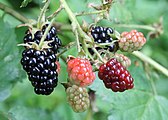 Blackberries belong to any of hundreds of microspecies of the Rubus fruticosusspecies aggregate.
Blackberries belong to any of hundreds of microspecies of the Rubus fruticosusspecies aggregate. The butterfly genus Heliconius contains many similar species.
The butterfly genus Heliconius contains many similar species.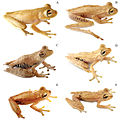 The Hypsiboas calcaratus–fasciatus species complex contains at least six species of treefrog.
The Hypsiboas calcaratus–fasciatus species complex contains at least six species of treefrog.
Hybridisation
Natural hybridisation presents a challenge to the concept of a reproductively isolated species, as fertile hybrids permit gene flow between two populations. For example, the carrion crowCorvus corone and the hooded crow Corvus cornix appear and are classified as separate species, yet they hybridise freely where their geographical ranges overlap.
- Hybridisation of carrion and hooded crows permits gene flow between 'species'
- Carrion crow
 Hybrid with dark belly, dark gray nape
Hybrid with dark belly, dark gray nape Hybrid with dark belly
Hybrid with dark belly Hooded crow
Hooded crow
Ring species
A ring species is a connected series of neighbouring populations, each of which can sexually interbreed with adjacent related populations, but for which there exist at least two "end" populations in the series, which are too distantly related to interbreed, though there is a potential gene flow between each "linked" population. Such non-breeding, though genetically connected, "end" populations may co-exist in the same region thus closing the ring. Ring species thus present a difficulty for any species concept that relies on reproductive isolation.However, ring species are at best rare. Proposed examples include the herring gull-lesser black-backed gull complex around the North pole, the Ensatina eschscholtzii group of 19 populations of salamanders in America, and the greenish warbler in Asia, but many so-called ring species have turned out to be the result of misclassification leading to questions on whether there really are any ring species.
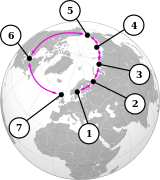 Seven "species" of Larusgulls interbreed in a ring around the Arctic.
Seven "species" of Larusgulls interbreed in a ring around the Arctic.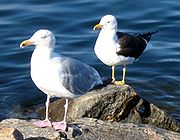 Opposite ends of the ring: a herring gull (Larus argentatus) (front) and a lesser black-backed gull (Larus fuscus)
Opposite ends of the ring: a herring gull (Larus argentatus) (front) and a lesser black-backed gull (Larus fuscus) A greenish warbler, Phylloscopus trochiloides
A greenish warbler, Phylloscopus trochiloides Presumed evolution of five "species" of greenish warblers around Himalayas
Presumed evolution of five "species" of greenish warblers around Himalayas
Attempts at definition
Biologists and taxonomists have made many attempts to define species, beginning from morphology and moving towards genetics. Early taxonomists such as Linnaeus had no option but to describe what they saw: this was later formalised as the typological or morphological species concept. Mayr emphasised reproductive isolation, but this, like other species concepts, is hard or even impossible to test. Later biologists have tried to refine Mayr's definition with the recognition and cohesion concepts, among others. Many of the concepts are quite similar or overlap, so they are not easy to count: the biologist R. L. Mayden recorded about 24 concepts, and the philosopher of science John Wilkins counted 26. Wilkins further grouped the species concepts into seven basic kinds of concepts: (1) agamospecies for asexual organisms (2) biospecies for reproductively isolated sexual organisms (3) ecospecies based on ecological niches (4) evolutionary species based on lineage (5) genetic species based on gene pool (6) morphospecies based on form or phenotype and (7) taxonomic species, a species as determined by a taxonomist.
Typological or morphological species
A typological species is a group of organisms in which individuals conform to certain fixed properties (a type), so that even pre-literate people often recognise the same taxon as do modern taxonomists. The clusters of variations or phenotypes within specimens (such as longer or shorter tails) would differentiate the species. This method was used as a "classical" method of determining species, such as with Linnaeus early in evolutionary theory. However, different phenotypes are not necessarily different species (e.g. a four-winged Drosophila born to a two-winged mother is not a different species). Species named in this manner are called morphospecies.
In the 1970s, Robert R. Sokal, Theodore J. Crovello and Peter Sneath proposed a variation on this, a phenetic species, defined as a set of organisms with a similar phenotype to each other, but a different phenotype from other sets of organisms. It differs from the morphological species concept in including a numerical measure of distance or similarity to cluster entities based on multivariate comparisons of a reasonably large number of phenotypic traits.
Recognition and cohesion species
A mate-recognition species is a group of sexually reproducing organisms that recognize one another as potential mates. Expanding on this to allow for post-mating isolation, a cohesion species is the most inclusive population of individuals having the potential for phenotypic cohesion through intrinsic cohesion mechanisms; no matter whether populations can hybridize successfully, they are still distinct cohesion species if the amount of hybridization is insufficient to completely mix their respective gene pools. A further development of the recognition concept is provided by the biosemiotic concept of species.
Genetic similarity and barcode species
In microbiology, genes can move freely even between distantly related bacteria, possibly extending to the whole bacterial domain. As a rule of thumb, microbiologists have assumed that kinds of Bacteria or Archaea with 16S ribosomal RNA gene sequences more similar than 97% to each other need to be checked by DNA-DNA hybridisation to decide if they belong to the same species or not. This concept was narrowed in 2006 to a similarity of 98.7%.
DNA-DNA hybridisation is outdated, and results have sometimes led to misleading conclusions about species, as with the pomarine and great skua. Modern approaches compare sequence similarity using computational methods.
DNA barcoding has been proposed as a way to distinguish species suitable even for non-specialists to use. The so-called barcode is a region of mitochondrial DNA within the gene for cytochrome c oxidase. A database, Barcode of Life Data Systems (BOLD) contains DNA barcode sequences from over 190,000 species. However, scientists such as Rob DeSalle have expressed concern that classical taxonomy and DNA barcoding, which they consider a misnomer, need to be reconciled, as they delimit species differently. Genetic introgression mediated by endosymbionts and other vectors can further make barcodes ineffective in the identification of species.
Phylogenetic, cladistic, or evolutionary species
A phylogenetic or cladistic species is an evolutionarily divergent lineage, one that has maintained its hereditary integrity through time and space. A cladistic species is the smallest group of populations that can be distinguished by a unique set of morphological or genetic traits. Molecular markers may be used to determine genetic similarities in the nuclear or mitochondrial DNA of various species. For example, in a study done on fungi, studying the nucleotide characters using cladistic species produced the most accurate results in recognising the numerous fungi species of all the concepts studied.Versions of the Phylogenetic Species Concept may emphasize monophyly or diagnosability.
Unlike the Biological Species Concept, a cladistic species does not rely on reproductive isolation, so it is independent of processes that are integral in other concepts. It works for asexual lineages, and can detect recent divergences, which the Morphological Species Concept cannot. However, it does not work in every situation, and may require more than one polymorphic locus to give an accurate result. The concept may lead to splitting of existing species, for example of Bovidae, into many new ones.
An evolutionary species, suggested by George Gaylord Simpson in 1951, is "an entity composed of organisms which maintains its identity from other such entities through time and over space, and which has its own independent evolutionary fate and historical tendencies". This differs from the biological species concept in embodying persistence over time. Wiley and Mayden state that they see the evolutionary species concept as "identical" to Willi Hennig's species-as-lineages concept, and assert that the biological species concept, "the several versions" of the phylogenetic species concept, and the idea that species are of the same kind as higher taxa are not suitable for biodiversity studies (with the intention of estimating the number of species accurately). They further suggest that the concept works for both asexual and sexually-reproducing species.
Ecological species
An ecological species is a set of organisms adapted to a particular set of resources, called a niche, in the environment. According to this concept, populations form the discrete phenetic clusters that we recognise as species because the ecological and evolutionary processes controlling how resources are divided up tend to produce those clusters.
Genetic species
A genetic species as defined by Robert Baker and Robert Bradley is a set of genetically isolated interbreeding populations. This is similar to Mayr's Biological Species Concept, but stresses genetic rather than reproductive isolation. In the 21st century, a genetic species can be established by comparing DNA sequences, but other methods were available earlier, such as comparing karyotypes (sets of chromosomes) and allozymes (enzyme variants).
Evolutionarily significant unit
An evolutionarily significant unit (ESU) or "wildlife species" is a population of organisms considered distinct for purposes of conservation.
Chronospecies
In palaeontology, with only comparative anatomy (morphology) from fossils as evidence, the concept of a chronospecies can be applied. During anagenesis(evolution, not necessarily involving branching), palaeontologists seek to identify a sequence of species, each one derived from the phyletically extinct one before through continuous, slow and more or less uniform change. In such a time sequence, palaeontologists assess how much change is required for a morphologically distinct form to be considered a different species from its ancestors.
Viral quasispecies
Viruses have enormous populations, are doubtfully living since they consist of little more than a string of DNA or RNA in a protein coat, and mutate rapidly. All of these factors make conventional species concepts largely inapplicable. A viral quasispecies is a group of genotypes related by similar mutations, competing within a highly mutagenic environment, and hence governed by a mutation–selection balance. It is predicted that a viral quasispecies at a low but evolutionarily neutral and highly connected (that is, flat) region in the fitness landscape will outcompete a quasispecies located at a higher but narrower fitness peak in which the surrounding mutants are unfit, "the quasispecies effect" or the "survival of the flattest". There is no suggestion that a viral quasispecies resembles a traditional biological species.
Change
Species are subject to change, whether by evolving into new species, exchanging genes with other species, merging with other species or by becoming extinct.
Speciation
The evolutionary process by which biological populations evolve to become distinct or reproductively isolated as species is called speciation. Charles Darwin was the first to describe the role of natural selection in speciation in his 1859 book The Origin of Species. Speciation depends on a measure of reproductive isolation, a reduced gene flow. This occurs most easily in allopatric speciation, where populations are separated geographically and can diverge gradually as mutations accumulate. Reproductive isolation is threatened by hybridisation, but this can be selected against once a pair of populations have incompatible alleles of the same gene, as described in the Bateson–Dobzhansky–Muller model. A different mechanism, phyletic speciation, involves one lineage gradually changing over time into a new and distinct form, without increasing the number of resultant species.
Exchange of genes between species
Horizontal gene transfer between organisms of different species, either through hybridisation, antigenic shift, or reassortment, is sometimes an important source of genetic variation. Viruses can transfer genes between species. Bacteria can exchange plasmids with bacteria of other species, including some apparently distantly related ones in different phylogenetic domains, making analysis of their relationships difficult, and weakening the concept of a bacterial species.
Louis-Marie Bobay and Howard Ochman suggest, based on analysis of the genomes of many types of bacteria, that they can often be grouped "into communities that regularly swap genes", in much the same way that plants and animals can be grouped into reproductively isolated breeding populations. Bacteria may thus form species, analogous to Mayr's biological species concept, consisting of asexually reproducing populations that exchange genes by homologous recombination.
Extinction
A species is extinct when the last individual of that species dies, but it may be functionally extinct well before that moment. It is estimated that over 99 percent of all species that ever lived on Earth, some five billion species, are now extinct. Some of these were in mass extinctions such as those at the ends of the Permian, Triassic and Cretaceous periods. Mass extinctions had a variety of causes including volcanic activity, climate change, and changes in oceanic and atmospheric chemistry, and they in turn had major effects on Earth's ecology, atmosphere, land surface, and waters. Another form of extinction is through the assimilation of one species by another through hybridization. The resulting single species has been termed as a "compilospecies".
Practical implications
Biologists and conservationists need to categorise and identify organisms in the course of their work. Difficulty assigning organisms reliably to a species constitutes a threat to the validity of research results, for example making measurements of how abundant a species is in an ecosystem moot. Paul Michael-Agapow and colleagues found that surveys using a phylogenetic species concept reported 48% more species and accordingly smaller populations and ranges than those using nonphylogenetic concepts; they note that this "taxonomic inflation" could cause a false appearance of change to the number of endangered species and consequent political and practical difficulties. The evolutionary biologist Jody Hey observes that there is an inherent conflict between the desire to understand the processes of speciation and the need to identify and to categorise. Conservation laws in many countries make special provisions to prevent species from going extinct. Hybridization zones between two species, one that is protected and one that is not, have sometimes led to conflicts between lawmakers, land owners and conservationists. One of the classic cases in North America is that of the protected northern spotted owl which hybridizes with the unprotected California spotted owl and the barred owl; this has led to legal debates.
The botanist Brent D. Mishler states that the species problem is created by the many ways that people want to use the species category, but argues that the solution is to abandon the traditional ranks and just use monophyletic groups of different inclusivess. A species is then "simply the least inclusive taxon" of whatever type. He argues that ecology, evolution, and conservation work are all better served by this approach. Since in his view species are not comparable, counting them is not a valid measure of biodiversity, and he calls for new ways to measure it, noting that other authors such as R. I. Vane-Wright and colleagues have proposed quantitative measures for phylogenetic biodiversity that make use of "the number of branch points, and possibly branch lengths, separating the tips on the tree".




